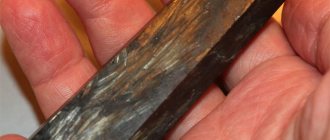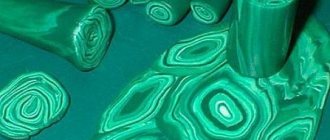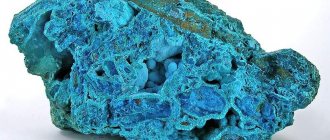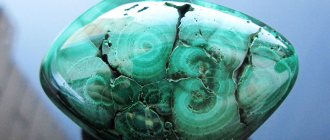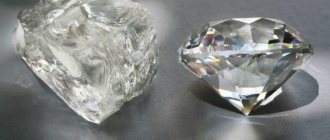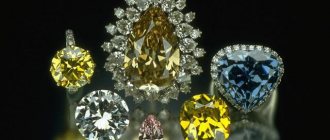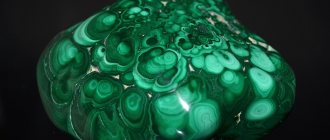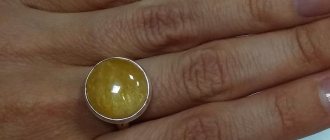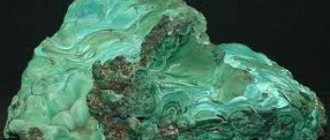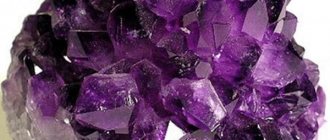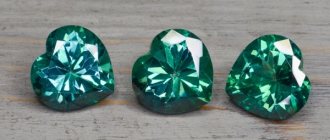| Property | Description |
| Formula | Cu2CO3(OH)2 |
| Impurity | Gland |
| Hardness | 3,5-4 |
| Density | 3.75 - 3.95 g/cm³ |
| Refractive index | 1,656 — 1,909 |
| Cleavage | Perfect. |
| Kink | Shellish and splintered. |
| singonia | Monoclinic. |
| Shine | Matte, in large quantities - silky, in crystalline form - glassy. |
| Transparency | Opaque. |
| Color and features | Green, green of different shades, from turquoise to very dark, depending on density. |
Consists of 71.9% CuO copper oxide (Cu 57%), 19.9% CO2 carbon dioxide and 8.2% H2O water. Expressed by the chemical formula Cu2(CO3)(OH)2. The outdated chemical name is copper carbonate.
Colors and varieties
The main color of malachite is always green, due to the large amount of copper. Gem varieties are distinguished by patterns, shades and impurities. The main varieties are:
- Finely patterned malachite. A gem with a large number of white inclusions and veins, very rare. Its pattern resembles birch leaves. A box made of this type of malachite inspired Pavel Bazhov when he wrote his Ural legends.
Finely patterned malachite
- Silk malachite, also known as corduroy or velvet. It consists of small “grains” of rock, which makes it very difficult to process. The gem feels like silk, suede or velvet to the touch.
Silk malachite
- Turquoise stone. If green malachite is copper hydroxide, then it is its phosphate, from a chemical point of view, a completely different stone. In appearance and texture it resembles its more famous brother, but is more hard and has a bluish tint.
Turquoise Stone
The pattern and depth of color depend on the location where the stone was dug. Samples from Namibia and Congo boast black regular circles that contrast strongly with the bright green main color of the crystal. In the Urals, malachites with a pattern of light straight lines are found.
Where was, where is...
There were two industrial deposits in the Urals - Mednorudyanskoye (Nizhny Tagil) and Gumeshevskoye (Polevskoye). Nowadays the mines and shafts here are closed and abandoned.
Mednorudyanskoye (Nizhny Tagil)
Gumeshevskoe (Polevskoe) mine
But in the rock dumps, lovers can find pieces of priceless greenery here.
Expert opinion
Semenishcheva Polina
Specialist in mineralogy. Graduated from St. Petersburg Mining University.
It happened and passed : a block of wonderful stone was extracted from the famous Gumeshki (weighing one and a half tons, this is not a brulik in a ring). Now it adorns the museum of the St. Petersburg Mining Institute.
Geologists pin their hopes on the Korovinsko-Reshetnikovskoye deposit, where malachite was discovered. How much of it there is remains to be explored.
Russia. There were two industrial deposits in the Urals - Mednorudyanskoye (Nizhny Tagil) and Gumeshevskoye (Polevskoye).
Jewelry malachite is mined in Africa (Congo, Zaire).
Nature sprinkled handfuls of gems in France, the mountains of Germany (Harz), and English Cornwall.
Kazakhstan
Malachite is also found:
- Jewelry malachite is mined in Africa (Congo, Zaire).
- Nature sprinkled handfuls of gems in France, the mountains of Germany (Harz), and English Cornwall.
- You can find malachite in Altai and Kazakhstan.
Magical properties of malachite
Malachite jewelry
From the moment malachite was discovered, the stone was credited with many unique magical properties, which are described in many ancient legends. Sorcerers and magicians recognized that the gem fulfills wishes and acts as a conductor between our world and other worlds of the Universe.
Ancient legends describe the mysterious disappearances and appearances of people, cases when a person became invisible. It was also believed that if you drink a drink from a malachite vessel, you will be able to understand the language of animals.
Malachite was considered a stone of nature, a forest gem - it was the forest that endowed the mineral with its power. Therefore, travelers wandering through the forest thickets took this gem with them. It was believed that the nugget protected a person from predators, arrows of savages, and helped to find the right path among animal paths.
The stone also has a dangerous side. Wearing it for a long time is not recommended, since the mineral awakens the natural animal nature in a person - intuition begins to prevail over logic, instant muscle reaction overshadows prudence and thinking, self-control gives way to free expression of feelings.
Ring malachite
In addition, mediums believe that the danger of malachite for women is expressed in the ability of the gem to attract men. At the same time, there is no division of people into good or bad - the mineral attracts suitors of any kind to the owner.
This is fraught with the fact that the young lady may end up in the hands of a not very decent man. You can protect yourself from this by wearing jewelry in a silver frame - this metal will help protect a woman from aggression, neutralizing the negative desires of men. In addition, silver enhances all the magical abilities of the mineral.
In the modern world, malachite acts as an assistant to speakers, artists, and all motivated individuals who want to achieve success. The stone makes such people more confident and eloquent. Businessmen can also enlist the help of a nugget by placing a malachite souvenir on their desk. Such a thing will attract good luck in business, directing success towards business development.
This is interesting!
One of the ancient legends says that malachite is able to warn its owner of danger. Signaling trouble, the mineral breaks into small pieces.
The gem bestows inspiration and new ideas on creative people, becoming a friend to poets, artists, and sculptors. This amazing mineral helps get rid of fears, calm your thoughts and soul, and relieve stress. By removing all blockages, the gem helps you find new ways to achieve your goals.
History and origin
Despite the centuries-old history of the mineral, no one knows exactly the meaning of its name. Most scientists are inclined to believe that the name “malachite” comes from the ancient Greek language, meaning the name of a plant with bright green leaves - mallow. Officially, the term “malachite” was introduced into mineralogy in 1747 by a Swedish scientist.
The most ancient places of mineral extraction reach an age of six thousand years, being the same age as the ancient Egyptian nation. The gem played a significant role in the formation of Kemet, an ancient state.
But the fact is that the original purpose of the stone was not the art of creating crafts or jewelry - malachite served as a source of copper, which was used by ancient peoples (Greeks, Hittites, Philistines, Egyptians) to make tools. The gem served this purpose for a long time, until the end of the Bronze Age.
When describing the appearance of malachite, one cannot limit oneself to one or two epithets. The magical greenery of this stone is mesmerizing. The charming color is complemented by an unusual pattern on the cut of the mineral, which consists of circles, ovals, “pupils”, ribbons and stripes of different shades of green, alternating with each other. Sometimes the appearance of the stone resembles velor or velvet - the surface of malachite seems so soft.
The Middle Ages finally made it possible to reveal the wonderful properties of the mineral, which ensure ease of processing and the creation of amazingly beautiful things. Humanity has found more convenient means of extracting copper, and European deposits of the stone have been depleted. Then malachite became attractive to craftsmen, who at that time already had access to making mosaic plates from the mineral.
The mineral has acquired special significance for Russia. Residents of the country who loved books learned about the extraordinary beauty of malachite from Pavel Bazhov’s fairy tale “The Malachite Box”.
Do you know that the Demidov family brought fame to malachite outside the country. Since the 30s of the 19th century, thanks to the Demidovs (a family of the richest Russian entrepreneurs (breeders and landowners) and French craftsmen, gemstones began to be used in architecture as a facing material. And in 1851, the World Exhibition was held in London, at which A.N. Demidov presented to the world a collection of products from his own malachite factory.
In one of the mansions in St. Petersburg, the architect O. Montferrand created the first malachite hall commissioned by P.N. Demidova. Almost at the same time, for Emperor Nicholas I, A. Bryullov decorated the malachite living room in the Winter Palace. The technique used to create these masterpieces was called “Russian mosaic”. This term was first used in the reports of the London World's Fair.
Today, visitors to the Hermitage are given the opportunity to appreciate the importance of the gem in national history. Tourists can see the entire Malachite Hall with more than 200 pieces of stone products. And the altar of St. Isaac's Cathedral is decorated with malachite columns.
So, for two centuries, the gem was revered as a symbol of a powerful state and one of the special treasures of the Ural Mountains, despite the extraction of other, more valuable minerals. Russian emperors of the 18th-19th centuries decorated their chambers with malachite, and presented decorative souvenirs made of stone as gifts to monarchs of other states.
Talismans, amulets, amulets
In Ancient Egypt, amulets were made for children to improve sleep and calm them down. The stone was believed to ward off evil spirits.
And in the Urals, a green patterned gem is considered a stone of joy and happiness. Products with malachite especially help people with a kind heart and pure intentions.
You can have a mineral even without cutting. It's great for meditation. It is better to purchase a stone in spring or summer, then it will help and support, and give strength.
Acquired in autumn and winter – carries the energy of withering.
Physical and chemical characteristics
The chemical formula of Malachite is Cu2(CO3)(OH)2. Its structure is copper carbonate.
When burned, the mineral turns into a black mass (copper oxide), releasing water vapor and carbon dioxide. Incomplete combustion produces pure copper, carbon monoxide and carbon dioxide, and water. In ancient times, metal was obtained in this way.
The material dissolves well in acids, which produces carbon dioxide. Ammonia also serves as a solvent; liquid with Malachite takes on a blue tint.
Basic physical properties:
- monoclinic system
- matte, silky shine
- color green, does not change under artificial light
- ray refraction value - 1.656-1.909
- Moss hardness – 3.5-4
- density - 3.75-3.95 g/cm³
- no transparency
The surface of the mineral can be easily polished due to its softness. But this property also leads to the fact that the stone quickly becomes dull and is easily scratched.
Healing properties
A figurine of a malachite bear.
Lithotherapists attribute the following to the medicinal properties of the Ural gem:
- normalization of an unstable emotional state;
- decreased blood pressure;
- relief of cramps in various diseases;
- relief of arthritis pain;
- relief of asthma attacks;
- in women - relief of pain during painful menstruation and childbirth.
Carefully!
Since malachite lowers blood pressure, it is not suitable for hypotensive patients!
Some experts even mention the fight against cancer among the healing properties of “Ural greens”. They claim that constantly carrying a large gem with you slows down the spread of metastases.
Malachite is a good object for meditation. If you look for a long time at the play and interpenetration of colors into each other on the surface of the stone, you can calm your nerves and smooth out aggression.
The lighter and brighter the stone, the higher its healing qualities. The abilities described above can be enhanced even more if you encase your specimen in copper.
From the history of stone
And Al-Kindi says: its deposit is in one cave in the mountains of Kirman [a city and region of southeastern Iran] among the copper mines... It is densely green, and green eyes and crescents are visible on it. Al-Kindi says: during the days of Persian rule, large pieces of malachite were found, from which it was possible to make vessels; then the pieces that were found gradually began to decrease until they completely dried up. Sepstansky [Sepstan is the area adjacent to the lake. Zarra, partly part of Iran and partly Afghanistan] malachite is lower in quality, and the one that comes from Arabia is inferior to both of them.
Areas of application
Vase made of malachite in the Hermitage
The properties of the malachite stone - strength and at the same time softness, beautiful patterns and unique colors - have ensured its popularity among jewelers. The gem is used to make jewelry, boxes, stands, vases, and candlesticks. They decorate columns and statues and lay out mosaics.
Back in the Middle Ages, craftsmen made figurines, chess pieces, and tabletops from Ural stone. The best works of art can be admired in the malachite room of the Hermitage.
Temples, for example, St. Isaac's Cathedral, were also decorated with gems.
Malachite products are still valued today. Figurines, watches, ashtrays from the best craftsmen are very expensive and can fit into any interior. Decorating with Ural stone tiles is also popular.
Since ancient Egypt, malachite ore has been used to produce copper.
No melting down
Copper is not mined from malachite now (and thank God
